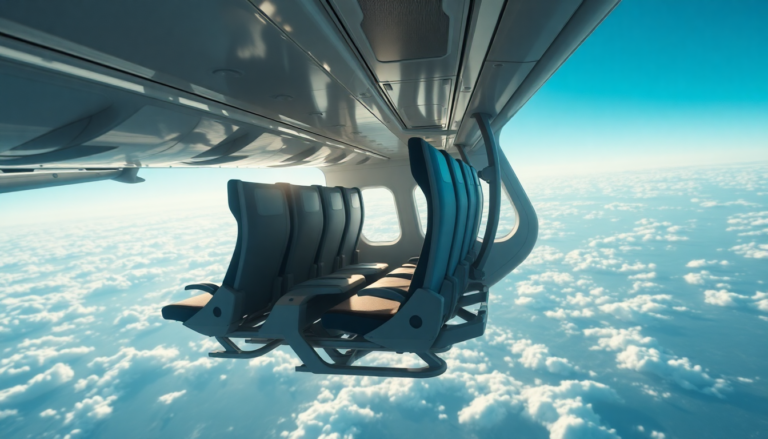Argomenti trattati
As the travel industry evolves, low-cost airlines are pushing boundaries with innovative concepts that raise eyebrows and invite curiosity. Enter Skyrider 2.0, a daring seating option set to debut in 2026, which offers a new way to travel without the luxury of traditional seats. This Italian invention by Aviointeriors proposes a vertical support structure with a saddle-like seat, allowing passengers to fly while semi-seated at a 45-degree angle. It’s a concept that’s both intriguing and contentious, stirring debates about comfort and practicality in the skies.
What is Skyrider 2.0?
Imagine boarding a flight where you don’t actually sit down, but rather lean against a padded, vertical support. That’s the essence of Skyrider 2.0. Designed to maximize space and minimize costs, this innovative seating arrangement weighs significantly less than traditional seats, providing airlines the ability to increase passenger capacity by up to 20% on short-haul flights. With a focus on short trips, particularly those lasting under two hours, this design caters to budget-conscious travelers looking for the most economical way to get from point A to point B.
Ensuring safety is paramount, and Skyrider 2.0 doesn’t compromise on this aspect. Each unit comes equipped with a safety belt for turbulence, and rigorous testing has confirmed that it meets all essential safety standards, including rapid evacuation tests. So, while the concept may sound radical, it’s been engineered with passenger safety in mind.
The economics behind Skyrider 2.0
At the heart of the Skyrider initiative lies a clear financial strategy: maximize profits by slashing operational costs. It’s a philosophy that low-cost carriers like Ryanair have embraced for years. Michael O’Leary, the CEO of Ryanair, has long been a proponent of unconventional flying experiences. The idea of “standing seats” has floated around since 2012, and now, with Skyrider 2.0, that vision is closer to reality than ever.
The prospect of snagging a flight for as little as 1 or 5 euros is undeniably tempting for many. Short routes between major European cities, like Madrid to Lisbon or Berlin to Prague, could become even more accessible, ushering in a new era of travel where comfort takes a backseat to affordability. Airlines would not only benefit from more passengers but also from reduced turnaround times due to simpler seat designs, requiring less maintenance and cleaning.
Passengers’ reactions and concerns
Despite the allure of ultra-low-cost travel, many travelers express skepticism about the practicality of flying while semi-seated. How comfortable can a 45-degree angle truly be? Particularly for taller individuals, the lack of a full seat might resemble a cramped subway ride during rush hour, leading to concerns of sore legs and aching backs. Some even joke about the potential for in-flight exercises, transforming flights into unexpected fitness sessions at 10,000 feet.
On the flip side, there are those who see Skyrider 2.0 as a breakthrough in budget travel. For them, the freedom to fly at a reduced cost outweighs the sacrifices made in terms of comfort. Personally, I believe there’s a unique thrill in the idea of flying at such low prices; it’s reminiscent of the early days of budget travel when everything felt fresh and exciting. However, the question remains: will people truly embrace this new mode of flying?
Looking ahead
While it’s uncertain whether Skyrider 2.0 will become the norm in air travel, its potential success could lead to a significant shift in the industry. Imagine a future where, during the booking process, you’re faced with the choice between a traditional seat and a lean option for a fraction of the price. For a spontaneous city break, some travelers might opt to stand just to save a few bucks. This concept may not suit everyone, but it certainly opens up conversations about the evolving landscape of air travel.
Only time will tell how this bold experiment will play out. Will it redefine budget flying, or will comfort ultimately prevail? For now, as many know, the skies are about to get a lot more interesting.

